Stop cannot be killed. Where to put a comma?
What is the essence of stopping action?
Article “Army pistol and the stopping action of pistol cartridges” the concept of stopping given by Dale Towert (D.Towert) was given: "The stopping power of a bullet is simply the ability of a bullet to hit a person and cause him to instantly stop any action that he performed at the time of the shot." At the same time, the stopping effect is the property of a bullet to ensure the complete inability of the target to attack and resistance when hit. Causing death in this context is regarded as the "lethal action of a bullet."
In my opinion, the concepts of “stopping action” and “lethal action” are inextricably linked. As long as the enemy is alive, there is always a risk that he will come to his senses and continue active resistance. Guarantee the absence of resistance from the enemy can only his complete and final death.
Based on this: The stopping action is the time of causing death to an object from the moment a bullet hits it - the speed of death. The shorter the time between a bullet hit and the onset of death, the higher the stopping effect.
You can talk about stopping action without causing death if this applies to gas cartridges, aerosol devices, stun guns and other arms for non-lethal effects. But the assessment of stopping action for non-lethal weapons will be even more complex and conditional due to the huge range of reactions of different people to external influences.
It would seem, based on their above definition, the stopping action of the ammunition could be characterized by a time characteristic - 1 second, two seconds and so on. The problem is that it is difficult to determine the time of death for all potential targets with a probability of 100%.
In this case, the probability of death can be considered as a quantitative estimate of the stopping effect: A quantitative measure of the stopping effect is the probability of causing death to an object, from the moment a bullet hits it, over multiple periods of time (presumably, 1 seconds).
That is, the higher stopping effect of the ammunition No. 1 in comparison with the ammunition No. 2 means that the ammunition No. 1 leads to death in a certain period of time with a higher probability than the ammunition No. 2. The numerical size of this probability characterizes the stopping effect of the ammunition.
Technically, the characteristic “stopping action of ammunition" may look like a line of probabilities of causing death in the first second, second second, third second, etc. Accordingly, the higher the probability of the death of the enemy in a shorter period of time, the higher the stopping effect.
How can one actually determine the probability of the death of a target at a particular point in time? It is extremely difficult to determine the stopping action characteristics by calculation, there are too many unforeseen factors determined by various mechanisms of the bullet’s impact on the target, although it is certainly necessary to develop methods for such a calculation.
But nevertheless, most likely, it will be necessary to create some breast targets from a ballistic gel, including the conditional "skeleton" and the "nervous system" from a network of conductors. When a bullet hits a target, it will break the conductors, which will track the movement of the bullet in the target in real time.
Indications of conductors should be superimposed on a virtual model, which should reflect the location of internal organs, simulate conditional bleeding in case of damage to blood vessels, organs, etc., and based on this, the estimated time of death, taking into account the available medical experience in the field of bullet wounds, is determined .
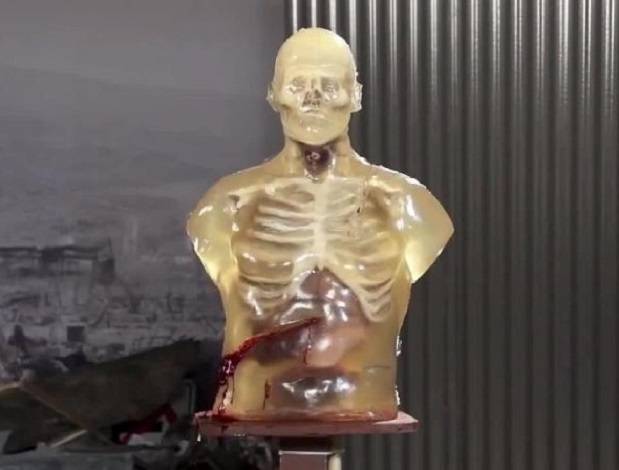
The target, of course, will be disposable. It is possible that to reduce costs, such targets will be printed on an 3D printer. It may seem to someone that this is difficult and expensive, but I see no other way to get information about the effectiveness of new and existing ammunition. In the end, the transition to testing on such targets is possible only after other types of tests - on accuracy, armor penetration, penetration into ballistic gel, etc.
Ammunition parameters providing a stopping effect
So what ammunition parameters provide a stopping action on the target, in accordance with the above definitions?
In fact, there are only two such parameters:
1. Damage caused directly by the body of the bullet.
2. Damage caused by secondary damaging factors: hydrodynamic shock, temporary pulsating cavity, bone fragments, etc.
According to the results of the FBI research from 1986, which was mentioned in the article “Army pistol and the stopping action of pistol cartridges”, only the direct hit of the target by a bullet can guarantee the destruction of the target: The temporary cavitation cavity created by the pistol (revolver) bullet does not play a significant role in the formation of the damaging effect. The stock of kinetic energy of a bullet at the moment of hit is also not significant. The organs of the body are destroyed if they are directly affected by a bullet.
The secondary factors mentioned in 2, although desirable, are extremely unpredictable in their effect. In other words, if a temporary pulsating cavity arises when a bullet hits, then this is good, but developing ammunition based on the need to create a temporary pulsating cavity is inappropriate.
Thus, the main damaging factor is mechanical damage caused directly by the body of the bullet.
Mechanical damage caused by a bullet can be increased by opening an expansive bullet, with a corresponding increase in its diameter, or by controlled fragmentation of the bullet into individual elements, which significantly increases the likelihood of damage to vital organs.
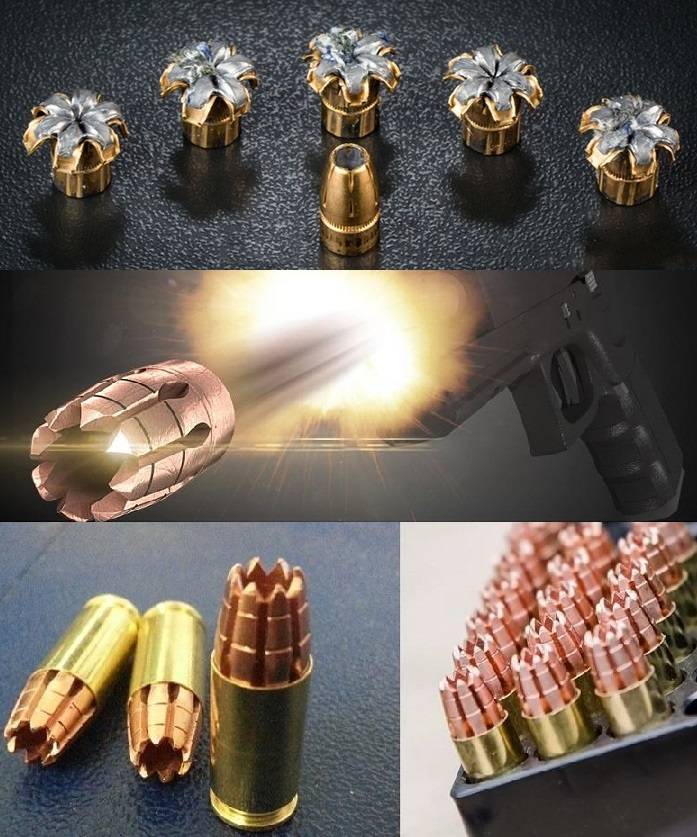
Tests 9-mm fragmented RIP bullet chicken carcass
The problem is that expansive and fragmented solutions work much worse for goals beyond the barrier, and do not always show consistently repeatable results. Depending on the situation, the expansive bullet may not open, and the fragmented bullet may not be divided into submunitions, which makes the result of their application unpredictable. This is indirectly stated in the previously mentioned FNB report of 1986 on the stopping action of ammunition: Although the expansion (expansivity) of bullets is desirable, one should not choose bullets that need to be opened to achieve the desired effect. In other words, the bullet must be effective, regardless of whether it managed to use its expansive qualities.
Nevertheless, with the adoption of the SIG Sauer P320 M17 pistol, the United States seems to have decided to cease to comply with the provisions of the Hague Convention 1899 of the year (which, however, they did not sign) by adopting M1152 and M1153 cartridges, the last of which is expansive (JHP) .
It is stated that the M1152 FMJ all-round cartridge is designed to defeat enemy soldiers, and the expansive M1153 cartridge (JHP) is necessary in situations where limited penetration of bullets is needed to reduce collateral damage.
However, for the new Russian pistol "Boa" there is also an SP-12 cartridge with an expansive bullet. Of course, it is possible that it will be used only by fighters of the Russian Guard and the Ministry of Internal Affairs, but apparently some of the provisions of the Hague Convention 1899 of the year will soon go to landfill stories following the missile defense treaty, the treaty on intermediate and shorter-range missiles and others.
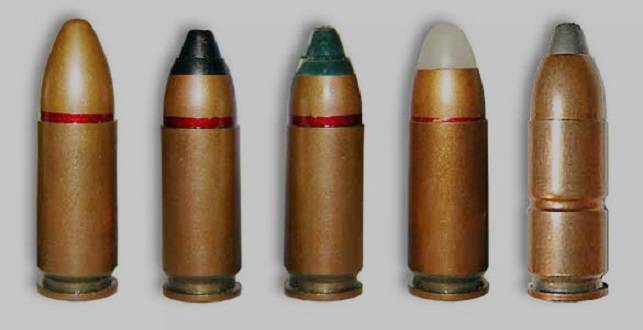
Another argument against expansive and fragmenting bullets is to reduce the depth of their penetration due to the energy spent on opening / fragmenting and increasing the cross section of the bullet / bullet fragments.
The penetration depth of the bullet is one of the critical indicators characterizing the damaging properties of ammunition.
It is this factor that does not always allow such ammunition as the 5,45x18 MPC to ensure a high probability of hitting targets. In some cases, the initial energy of the bullet may simply not be enough to penetrate the body to the depth necessary to defeat vital organs.
What penetration depth can be considered optimal? The FBI Commission claims to be about 25 centimeters. However, there are certain nuances regarding the penetration depth. Let's consider three options:
1. The bullet entered the body, but did not penetrate deep enough to damage vital organs.
2. The bullet entered the body deep enough and stopped in the body.
3. The bullet passed right through.
Which option is the best? Option number 1 we sweep away immediately, everything is clear with it. But with the options No. 2 and No. 3 is not so simple. It is believed that the bullet should remain in the body, completely transferring its energy to the body. The question is, what does “transfer energy” mean from a practical point of view? You can transfer energy in different ways, what will a bullet spend its energy on, not for heating the body?
No, she will spend it on the mechanical destruction of body tissues, in the presence of NIB, on their destruction, as well as on the deformation of the bullet itself during movement in the body and overcoming NIB. By the way, one of the tasks to be solved when designing armor-piercing bullets of the caliber 9 mm is the choice of such a shape of the shirt of the core of the bullet that would minimize the speed of the bullet during separation, when NIB is pierced, but somehow, part of the energy goes into this.
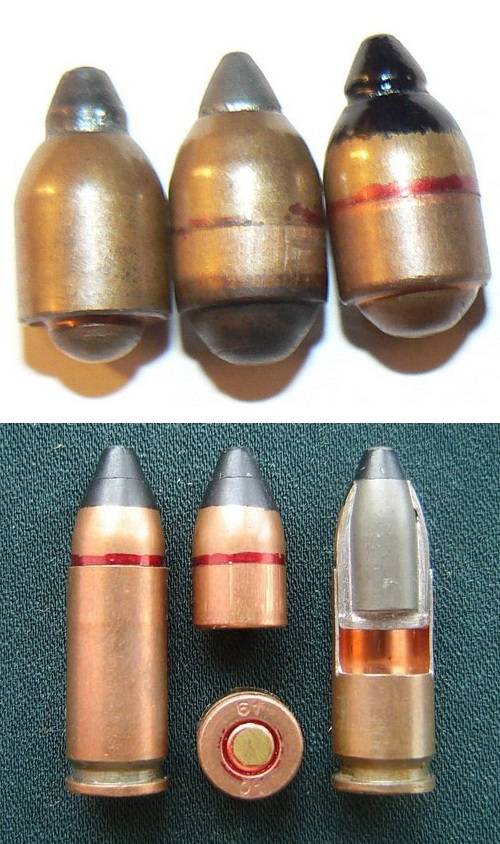
Consider two options: one bullet entered the body in 1000 J energy and exited (through penetration) with 400 J energy, and the second entered the body with 500 J energy and remained in it. Which one will do more damage, which has a higher stopping effect? Formally, the first gave up more energy. But what about the fact that the bullet stuck in the body is more lethal, and in general opinion the stopping effect is higher precisely in the case when the bullet remains in the body?
It is possible that this is more connected not with the fact of energy transfer, but with the fact that the bullet remaining in the body continues to exert pressure on internal tissues, causing additional injuries, increasing bleeding, especially when the body moves.
Ways to increase stopping power (death rate)
What methods can be implemented to increase the transfer of bullet energy to tissue destruction and bullet retention in tissues? First of all, this is a change in the shape of the bullet, for example, the implementation of bullets with a flat rather than lively tip, as is done in the aforementioned M1152 cartridge of the caliber 9x19 mm for the US armed forces. The flat head of the bullet also reduces the likelihood of a rebound.
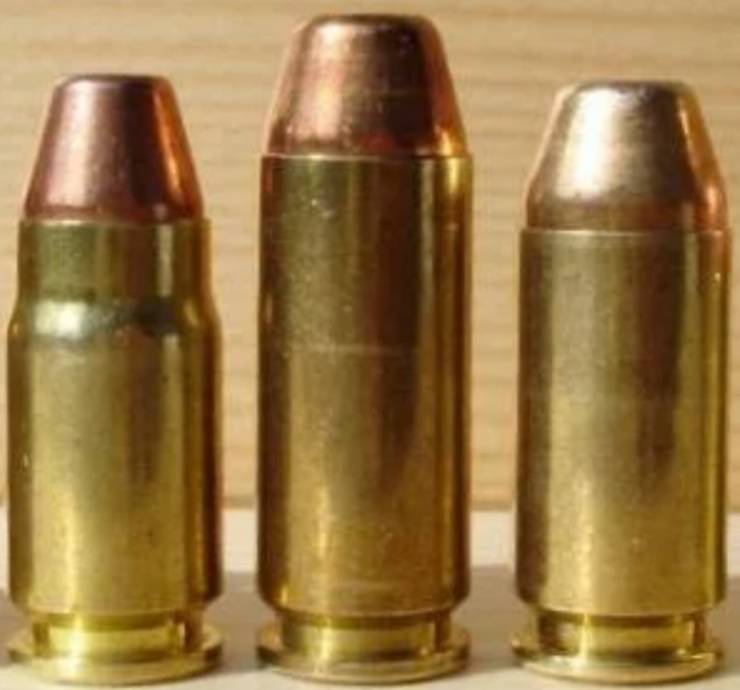
If we go back to the conversation about the transition from the cartridge 7,62x25 mm to the cartridge 9x18 mm, the use of a flat head part of the bullet could well solve the problem of penetrating the body through the bullet of the cartridge 7,62x25 mm. Moreover, a higher initial energy of the 7,62x25 mm TT cartridge bullet would provide a greater penetration depth with a corresponding increase in the likelihood of damage to vital organs.
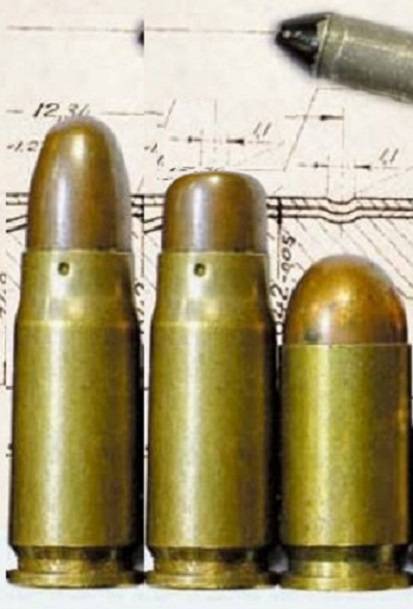
Another option is bullets with low stability, which when hit in the body begin to tumble, which significantly increases the damage done.
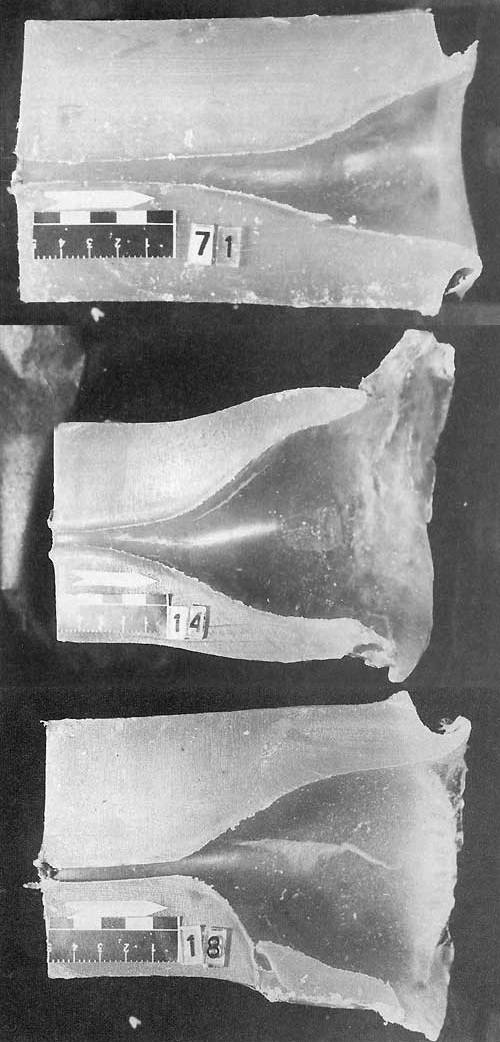
Does size matter?
In the context of the fact that the main damaging factor is the mechanical destruction of organs by the body of the bullet, how much influence will the increase in caliber have? Of course, a bullet with a diameter of 11 mm will form a larger wound channel than a bullet with a diameter of 5 mm, unless of course we consider the option of an unstable bullet, but how much greater stopping effect (read the rate of onset of death) will give in quantitative terms, can only be determined by the test results, the estimated the method of carrying out which is described above.
Based on the analysis of the ammunition used for hunting, it can be assumed that the priority factors providing a high stopping effect are the initial energy, shape and composition of the bullet material. The ammunition gauge in this case is a secondary factor, which is determined based on the required energy, the shape and material of the bullet, as well as the requirements of external and internal ballistics.
With regard to army weapons, in which bursts of fire or short bursts can be realized, it is necessary to choose the minimum caliber that allows you to implement the requirements of the previous paragraph. At the same time, the stopping effect of the weapon-cartridge complex is increased due to the destruction of the target simultaneously by several ammunition, as was considered in the article “A promising army pistol based on the PDW concept”.
This is again indirectly stated in the FBI report from 1986 of the year: Since an immediate hit on the target cannot be guaranteed by any combination of calibers and bullets, the FBI agent must fire on the hit as long as the target poses a real threat. Therefore, all experts recommended the use of weapons with a larger capacity stores.
Speaking about comparing the stopping effect of bullets with a diameter of 11 mm and a diameter of 5 mm with equal energy, it is necessary to take into account a significant reduction in ammunition for ammunition of a larger caliber. Therefore, it is justifiable to compare the stopping action of one bullet with a diameter of 11 mm and two bullets with a diameter of 5 mm. At the same time, to ensure the same penetration depth, the energy of a bullet with a diameter of 11 mm should be higher than that of two bullets with a diameter of 5 mm, which in turn significantly complicates the firing of such weapons. The need to defeat targets protected by NIB is also an argument in favor of small-caliber weapons.
If we talk about “A promising army pistol based on the PDW concept”, then firing in short bursts of two shots allows you to implement the combined use of ammunition, with a different type of damaging effect. For example, when one bullet is made in a variant with high armor penetration, as with cartridges 5,45x39 mm, 5,56x45 mm, 5,7X28 mm, and the second bullet is made with a flat head. At the same time, they are equipped in the store in turn, and in the main mode of firing in short bursts of two rounds, the positive qualities of both versions of the bullets are added up.
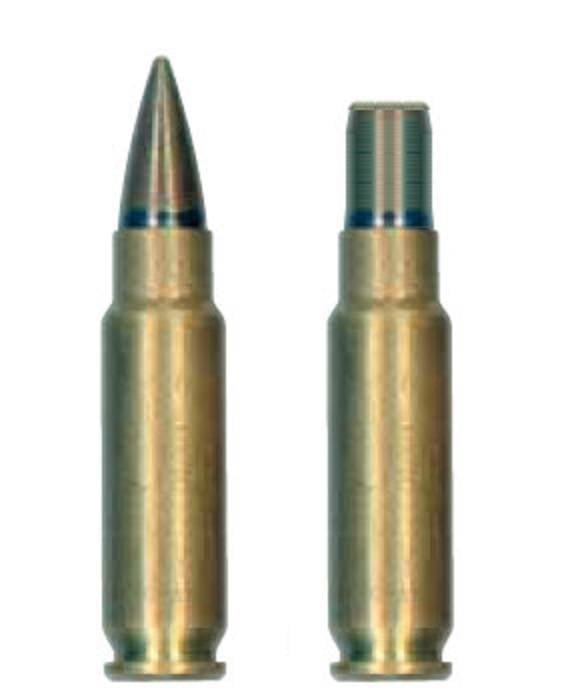
Thus, when firing at a target protected by NIB, a bullet with a flat head makes an impact on the target (if possible) without penetration, while, possibly, NIB elements will be damaged, and the second bullet, with increased armor penetration, penetrates the NIB and target defeat. When shooting at a target that is unprotected by NIB, a bullet with a flat head penetrates the body to a sufficient depth and remains there, injuring the internal organs as much as possible, and the second bullet, with increased armor penetration, hits the target with the effect characteristic of bullets with low stability, it is assumed that in some cases it can perform through penetration of the target.
However, the assumption that it is possible to use a combined variant, when firing simultaneously with two types of bullets, can be refuted by the test results, which show that the simultaneous use of two bullets with increased armor penetration and low stability will show comparable or higher efficiency.
Does it then make sense in pistol cartridges of the 9-11 mm caliber, if you do not take into account the established stereotypes? Yes, if we are talking about civilian or police weapons, which are forbidden to fire in bursts and it is necessary to limit the range of a bullet, to prevent accidental damage to unauthorized persons. This is especially true for civilian weapons, in which artificial restrictions can be set on the capacity of the store, for example, up to ten rounds. Given that both the police and civilians are significantly less likely to meet with the enemy, protected by NIB, the role of expansive and fragmenting bullets increases if they are allowed for use by the legislation of a particular country.
But for promising army pistol, in which it is necessary to ensure both a high stopping effect (death rate) and hitting targets protected by NIB, the best solution is to use small-caliber ammunition in combination with firing in short bursts of two shots.
- Andrey Mitrofanov
- huntersclub.com.ua, thetruthaboutguns.com, shkolazhizni.ru, armoury-online.ru, weaponland.ru
- Army pistol in Russia. Part of 1
Army pistol in Russia. Part of 2
Army gun in the USA. Part of 1
Army gun in the USA. Part of 2
About ammunition, army pistols and submachine guns in the RF Armed Forces
Army pistol and stopping action of pistol cartridges
A promising army pistol based on the PDW concept
Carabiner kit and attachments for a promising pistol
Caliber 9 mm and stopping action. Why 7,62x25 TT replaced by 9x18 mm PM?

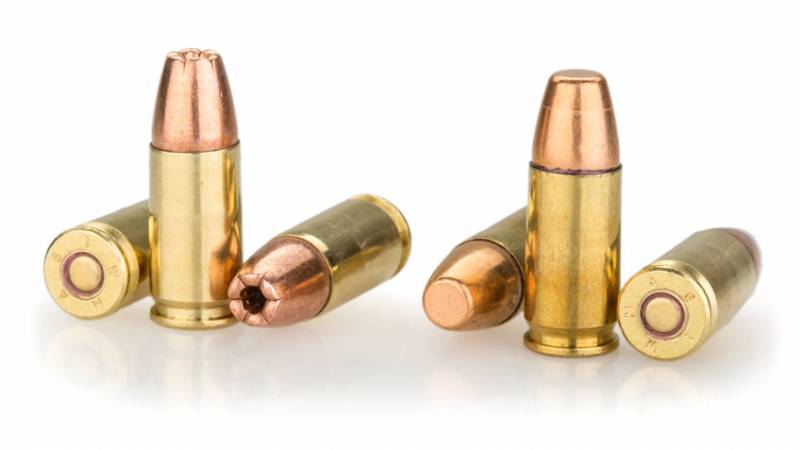
Information